Dr. Barbara Stumpp, Freelance Science Writer
LEDs top almost every other illuminant in lifetime and performance, but – unfortunately – also in production costs. This is where molded interconnect devices come in, offering considerable freedom for the arrangement of LEDs and much more efficient production
with cost-saving potential.
Light-emitting diodes provide the backlighting for liquid crystal displays, give cars their brand-specific lighting design and, for example, illuminate the 49,000-m2 outfield of the Innsbruck airport without significant light pollution. What counts here is long-term stability, low power requirements, low construction depth and a possible lifetime of some 10,000 hours.
However, private households also can save power with LEDs. If the average consumer needs to buy a new bulb for an LED lamp at up to €15 – about five times the cost of a halogen lamp – he sees mainly the price and not the long lifetime or the 80 percent lower power consumption.
One reason for the high piece cost lies in the structure of the LED component: It is flat and radiates to only one side. For 300° light emission, optics and reflectors are needed for LEDs, or they must be placed in diffuser domes. A reasonable solution is to arrange LEDs in geometries similar to the spiral-wound filament of a bulb.
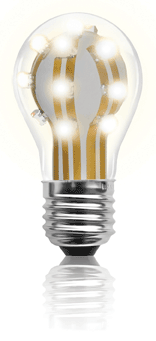
LEDs can even be designed in a traditional lightbulb shape. Courtesy of LPKF.
LEDs use only direct current, so they need electronic components that convert alternating current into direct current. Also, dimming capability would be preferable, and that requires additional electronics. In the age of the networked home, many still dream of a suitable light-management system, so it would make sense to drive LEDs via components similar to RFIDs (radio-frequency identification) to eliminate the need to pry open the walls for the necessary cables. Sensors that automatically control the lighting require even more electronics for the LED lamp. And to top it all off: If white light is generated not by light conversion but by mixing the light from red, green and blue LEDs, the color must be controlled through additional electronics. To prevent LED lighting from becoming astronomically expensive, new solutions are needed to make not only the high-tech version of LED lighting cheaper, but also a normal, everyday LED lamp.
The molded interconnect devices (MID) process offers both cost-efficient production and geometric leeway. With this process, interconnects and electronic components are placed directly on a 3-D plastic body. Among the various MID processes, laser direct structuring (LDS) dominates. This method uses a thermoplastic material doped with a laser-activatable additive. When the laser beam hits this substrate, it uncovers the additive and forms a roughened track. The additives provide the seed for the subsequent electroless plating in an electroless plating bath. Circuit paths made of copper with a thickness of up to 10 µm, followed by a finish with nickel and gold, are common. For higher currents and heat sink functionality, thicker layers can be produced by electrolytic plating. In industrial applications, laser systems with up to four processing units provide short cycle times.
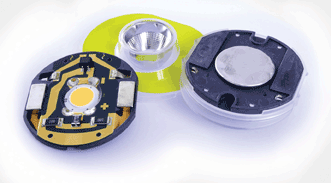
In the Clip n’Slide track system from HomeLights, the clips –
produced by means of laser direct structuring technology – adhere
to a magnet on the track. Photo courtesy of LPKF.
With a newly developed technique by LPKF Laser & Electronics AG of Garbsen, Germany, LDS prototypes can be realized quickly and cost-effectively. The step from idea via prototype to mass production is short – but the time to market decreases significantly. “The LDS method has proven its suitability for mass production for years. Thus, for example, conductor structures and antennas can be applied on mechanical components,” said Stephan Krause, strategic product manager for LDS at LPKF. Some materials can be pierced by means of the laser. During this procedure, the wall of the borehole is activated. During metallization, an electrical connection is created to the other side of the wall, a through-hole plating.
For electronic components applications, the Hydra placer by Essemtec of Aesch, Switzerland, can produce up to 2500 components per hour in 3-D mode. “The problem was that the gravity affects the dispensing and placing on a nonhorizontal surface,” said Florian Schildein, marketing and sales manager at Essemtec. An integrated robot works inside the machine, but – unusually – the device for moving parts works as a master, while the robot functions as a slave.
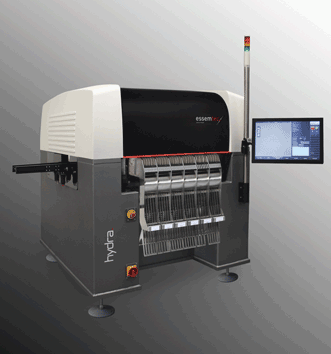
The Hydra assembly unit, seen here from the outside, can
produce up to 2500 components per hour in 3-D mode for electronics
applications. Photo courtesy of Essemtec.
The result is a 2-D pick-and-place machine combined with a specific substrate holder, positioned to the required angle by the robot. “Glue and solder can keep the components even when the part is upside down. But design requirements have to be considered,” Schildein said. The facility can process substrates with a size of 300 x 300 x 50 mm and a weight of up to 2 kg with a placement accuracy of less than 60 µm. In this manner, the Hydra offers systems engineering close to that of mass production.
During operation, LEDs become hot, despite efficient electricity use. “LEDs can withstand a junction temperature of 125 to 135 °C – at the most, 185 °C for a long lifetime. Moreover, the LED driver influences the life span. Therefore, it does not work without thermal management, while [the LEDs’] performance depends on the shape of the luminous element,” said Rudi Hechfellner, the former director of applications at Philips Lumileds. In a fixed linear arrangement, aluminum rails are sufficient. Two-dimensional LED lamps need a heat sink. “One needs a heat sink [that] offers the required mechanical stability and [also] meets the country-specific certifications,” Hechfellner said. Heat management for an LED lamp was such a challenge.
LPKF has faced this problem with an LDS-compatible powder coating. Spatial metallic base bodies become bearers of components as well – LEDs, in this case. Mid-Tronic has created a demonstrator: “A massive aluminum body acts as a heat sink, which was coated with a white LDS-compatible powder coating,” said Karl Görmiller, CEO of Mid-Tronic.
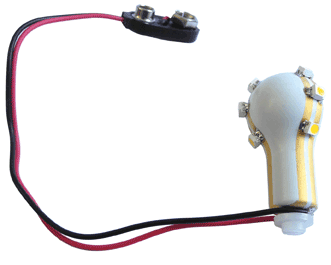
The LPKF-LDS powder paint enables circuit paths to be placed
on any 3-D metal body, providing new options for LED technology.
Courtesy of LPKF.
The LDS powder coating is applied on the aluminum body and cured. The conductor paths are then structured by the laser and metallized. The resulting demonstrator works splendidly but is, of course, a bit too heavy. “We first wanted a functioning part and, in the future, instead of a massive body, I envision a hollow aluminum body, manufactured by [a] low-cost injection molding process,” Görmiller added.
Galvanic boosting to reach the desired layer thickness after electroless metallization enables higher layer thicknesses of conductor tracks – 35 to 70 µm – on the plastic components for improved heat dissipation. Because most of the heat passes through the substrate, the development of thermally conductive, LDS-compatible plastics is due.
The development and launch of the LDS powder coating is expected soon. “The big advantage will be that LEDs can be placed directly on the heat sink; further, the LDS process makes a circuit board and a thermal interface material redundant,” said LPKF’s Krause.
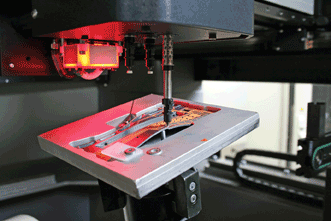
A view inside the Hydra assembly unit: A robot places the component in the working chamber.Photo courtesy of Essemtec.
“We reach [heat conduction] in polymers by means of fillers, since there is only one problem: Too much filler can make the polymer brittle,” said Dr. Christoph Heinle, director of R&D at RF Plast GmbH. Because there is a large number of fillers [with] a large width of thermally conductive properties, [the user can] find the right mix to any application. As the production of the LED base body must be inexpensive, injection molding will continue to be the method of choice.
“Fillers in injection-molded parts [don’t have] the same orientation everywhere. This orientation is determined by the place in the component, so the conductivity is not the same throughout the whole component. We have identified where, depending [on] part geometry, the thermal conductivity is the greatest. With that said, we are able to design suitable parts of which the heat conduction is at its maximum at the desired LED place,” Heinle said, summarizing the results of RF Plast’s research. The advantage: Design work optimizes the effect, and the material price takes a back seat.
All in all, MID technology for lighting is efficient, cost-effective and ready for series production – and an appropriate automatic placement machine is already available. “With this method, an almost unlimited number of surface geometry for LED lamps is available; additionally, it works with free-form substrates,” Krause said. With the use of thermally conductive plastics instead of aluminum, productivity continues to rise.
A quick design change helps to save money. Also, additional electronic components and functions can be integrated without adding process stages. Thus, LED lights become lighter, smaller and cheaper.
Meet the author
As a freelance technical journalist, Barbara Stumpp supports various companies in their external communications on complex products; email: [email protected].